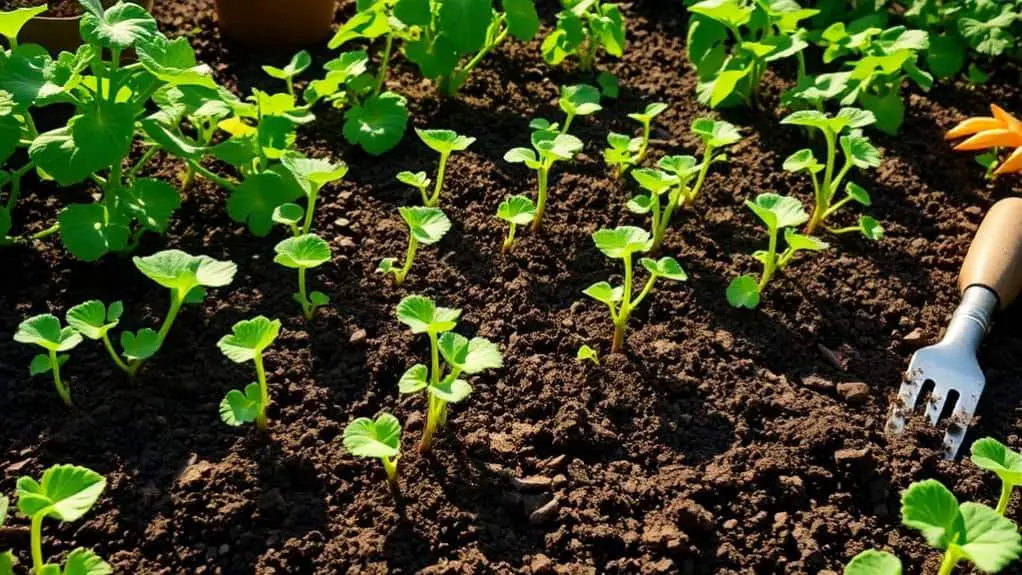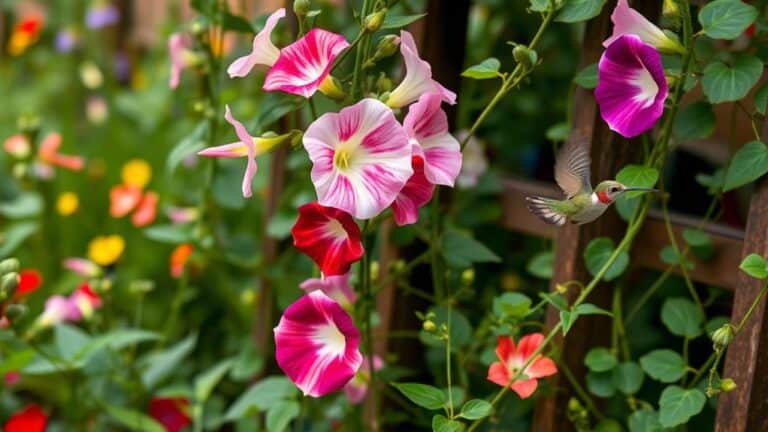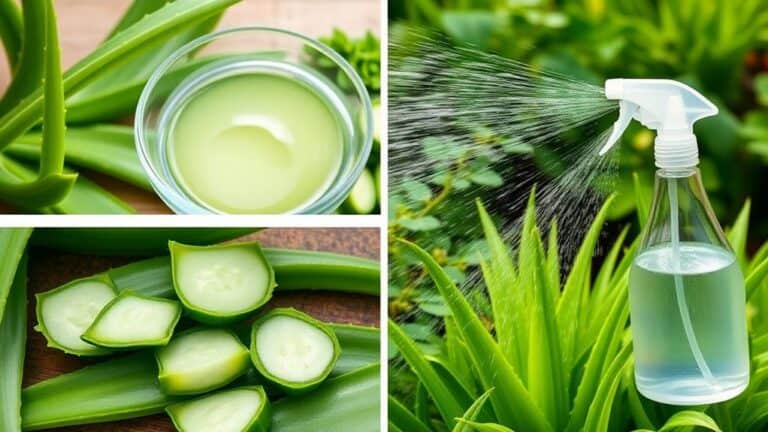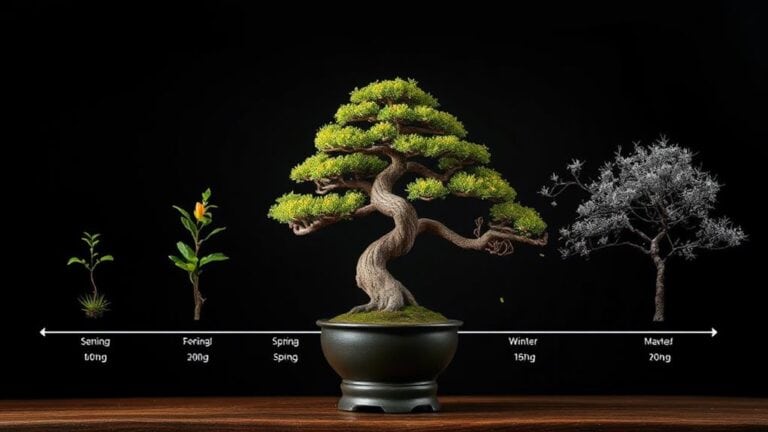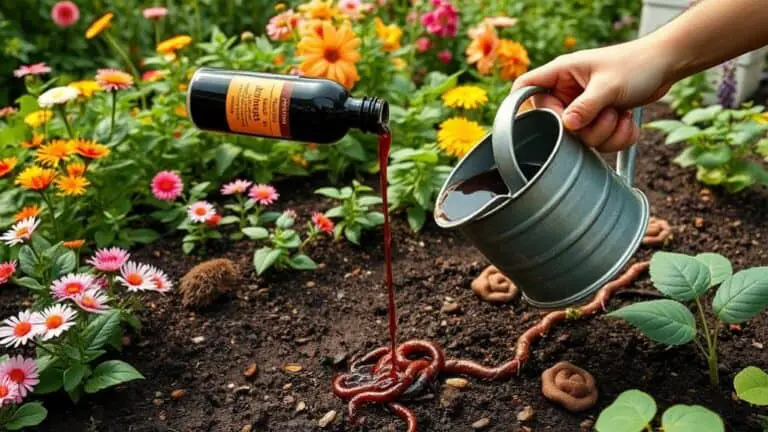How Far Apart Should Cucumbers Be Planted Garden
When it comes to planting cucumbers, getting the spacing right is essential for a successful harvest. I've learned that vining varieties require a different approach compared to dwarf bush types. For instance, spacing them 36-60 inches apart on the ground or 12 inches apart on a trellis can make a significant difference. On the other hand, dwarf bush varieties can be closer, around 1 to 2 feet apart. But how do these spacing strategies impact air circulation, pest management, and ultimately, the quality of your cucumbers? Let's explore these aspects further.
Ideal Growing Conditions
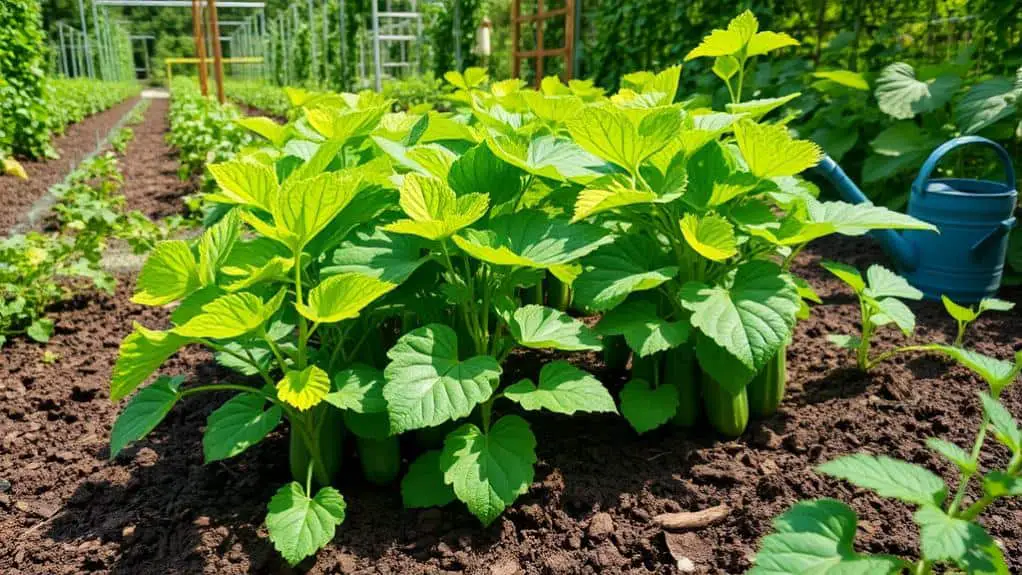
When it comes to growing cucumbers, ensuring the ideal conditions can make all the difference.
Cucumbers love warm temperatures, so plant them after the last frost when the soil hits around 70°F. They need full sun exposure, ideally 6 to 8 hours daily, for optimal growth and fruit production.
The soil should be well-drained and slightly acidic, with a pH between 6.0 and 6.8. Consistent moisture is vital, so aim for at least 1 inch of water per week.
Mulching helps retain moisture and keeps weeds at bay. Space your plants properly to avoid overcrowding.
Adding aged compost or rich organic matter can improve the soil's fertility and drainage, promoting healthier cucumber plants.
Soil Preparation Tips
Proper soil preparation is essential for growing healthy cucumber plants. Start by mixing aged compost or rich organic matter into your garden to boost nutrient content and create well-drained soil.
Aim for a soil pH between 6.0 and 6.8, though cucumbers can handle up to 7.6. In cool springs, cover the soil with black plastic to warm it by 3-4 degrees Fahrenheit, which helps with earlier planting.
Keep the soil consistently moist, ensuring at least 1 inch of water each week. Instead of fresh manure, use well-rotted compost to avoid nutrient imbalances and disease.
With these soil preparation tips, your cucumber plants will have the best foundation for a successful growing season!
Direct Sowing Guidelines
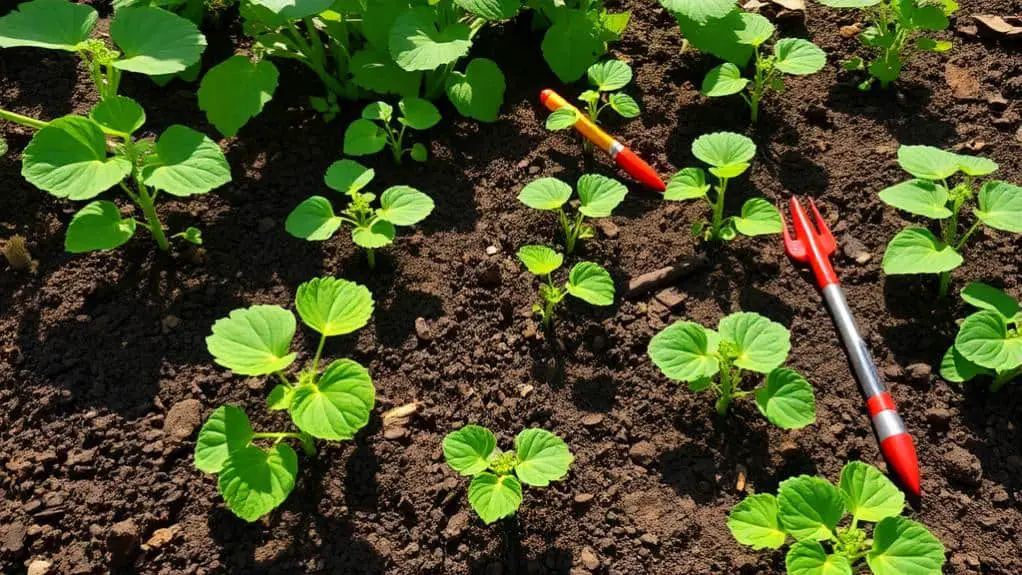
Getting your cucumber seeds directly into the ground at the right time can make all the difference in their development. Wait until soil temperatures reach at least 70°F.
Plant cucumber seeds an inch deep in clusters, spacing them 3 to 6 feet apart for ideal growth. Once they germinate, thin seedlings to one per cluster for adequate space. This spacing helps with air circulation and access.
Consistent watering is essential, as well as monitoring for pests. If you choose to go with row planting instead, maintain the same distance between clusters.
Growing vertically can also enhance space efficiency. By following these guidelines, you'll set your cucumbers up for a healthy, productive growing season.
Trellis Planting Method
Elevate your cucumber gardening game by utilizing the trellis planting method. Start by sowing cucumber seeds in clusters of 3 to 4 at the base, spaced one foot apart.
Once germinated, thin them to one plant per foot to guarantee peak growth and air circulation. The trellis planting method uses vertical space, giving your cucumbers better sunlight exposure and making harvesting easier.
Elevating the plants keeps the fruit clean and reduces soil-borne diseases. Plus, the improved airflow around the plants helps prevent humidity-related issues like powdery mildew.
Ground-Level Planting
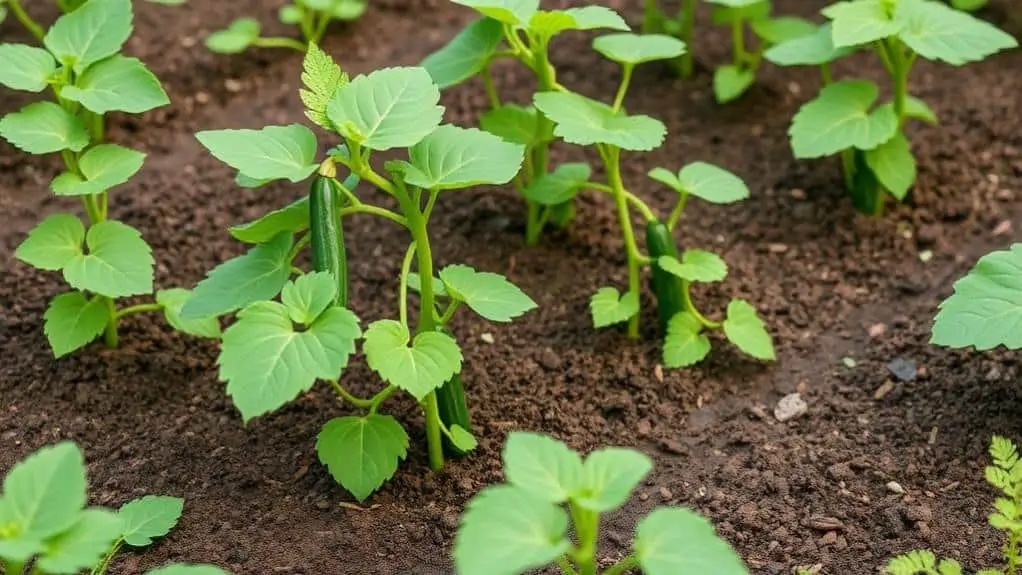
While the trellis planting method offers many benefits for cucumber growers, ground-level planting is another effective technique that shouldn't be overlooked. When planting cucumbers at ground level, guarantee seeds are spaced 10-12 inches apart. This spacing allows for adequate growth and air circulation, reducing the risk of humidity-related diseases. Rows should be spaced 18-24 inches apart, providing enough room for maintenance and harvesting.
| Task | Distance | Benefit |
|---|---|---|
| Seed spacing | 10-12 inches | Adequate growth and air circulation |
| Row spacing | 18-24 inches | Easier maintenance and harvesting |
| Cluster spacing | 18-24 inches | Minimizes competition |
Proper spacing guarantees each cucumber plant gets sufficient nutrients and sunlight, promoting healthier growth and increased yield.
Proper Plant Spacing
When planting cucumbers, it's important to follow specific spacing guidelines to guarantee they grow well and produce lots of fruit.
Vining cucumbers need 36-60 inches apart if they're on the ground, while those on a trellis only need about 12 inches between plants.
Proper spacing helps the plants get enough nutrients and sunlight, and it also improves air circulation, which keeps them healthy and less likely to get diseases.
Optimal Spacing Guidelines
Proper spacing is essential for growing healthy cucumber plants, whether you're working with trellised, ground-sprawling, or dwarf bush varieties.
Trellised cucumbers should be spaced 12 inches apart for good air circulation. Ground-sprawling vining cucumbers need 36 to 60 inches to thrive without competing for nutrients and sunlight. Dwarf bush varieties can be planted closer together, about 1 to 2 feet apart, making them great for smaller gardens.
- Trellised cucumbers: 12 inches apart
- Ground-sprawling cucumbers: 36 to 60 inches apart
- Dwarf bush varieties: 1 to 2 feet apart
- Minimum spacing for small varieties: 1 foot
- Spacing for larger vining types: up to 6 feet
Proper spacing reduces humidity, lowering fungal disease risks and enhancing plant health.
Benefits of Spacing
After understanding the ideal spacing guidelines for different cucumber varieties, it's important to recognize the tangible benefits that proper plant spacing brings.
When you space your cucumbers correctly, you guarantee adequate air circulation, which helps prevent humidity-related diseases like powdery mildew. This leads to healthier growth and better fruit quality.
Proper spacing also allows your cucumbers to access essential resources like sunlight, water, and nutrients, promoting robust development.
Overcrowded plants can struggle with pest management, but adequate spacing improves airflow, deterring pests like cucumber beetles and aphids.
Finally, correctly spaced cucumbers make harvesting more efficient and less damaging to the plants.
Pollination Needs
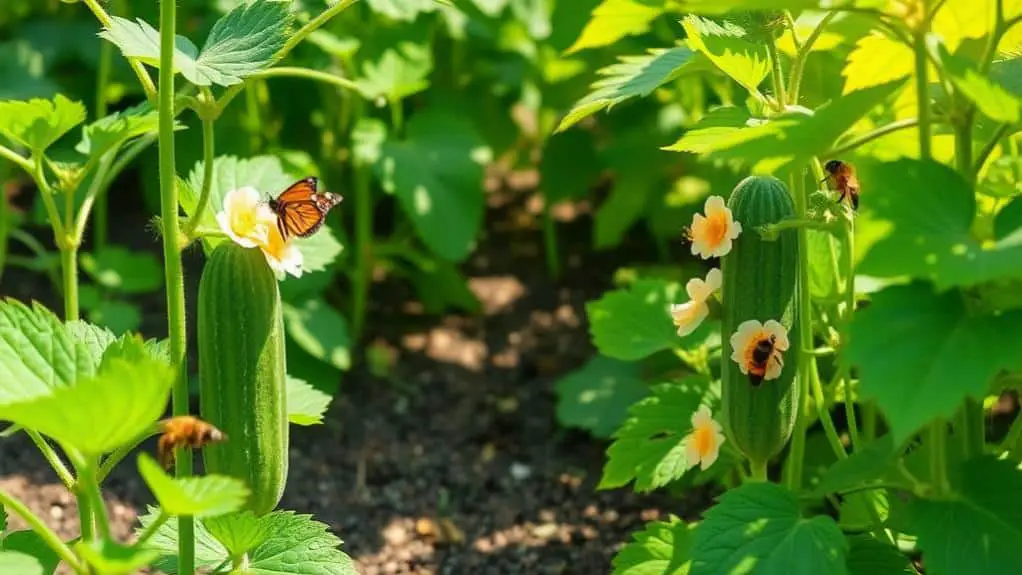
Pollination is super important for cucumbers, and bees are the heroes in this process.
Cucumbers have both male and female flowers, with the males showing up first and the females sporting tiny, swollen bases where the fruit will grow.
To make sure your plants produce lots of cucumbers, keep an eye on the bees buzzing around your garden, especially in the morning when they're most active.
Importance of Bees
Bees play an essential role in the successful cultivation of cucumbers, as these plants produce separate male and female flowers that rely on pollinators for fruit development.
When I'm planting cucumbers, I always consider the importance of a healthy bee population in my garden. Bees are vital for transferring pollen, especially during the morning when they're most active. Without them, cucumber plants might bloom but won't produce fruit, leading to disappointing yields.
Here are a few tips to boost bee activity:
- Avoid using pesticides that can harm bees.
- Plant a variety of flowering plants near cucumber beds.
- Guarantee the garden blooms throughout the growing season.
- Maintain a habitat that supports bees' needs.
- Observe bee activity to adjust planting strategies.
A healthy bee population means a thriving cucumber garden!
Flower Gender Roles
When planting cucumbers, it's important to understand the distinct roles of male and female flowers in pollination. Male flowers appear first, providing the pollen needed for female flowers to develop fruit.
Pollination is vital for fruit development, and bees and other pollinators play a big role in this process. They're usually most active in the morning when flowers are open.
Some cucumber varieties are parthenocarpic, meaning they can produce seedless fruit without pollination. However, all-female varieties still need pollen from male flowers.
Be cautious with pesticides, as they can harm pollinator populations, leading to reduced pollination and lower yields. Understanding these flower gender roles helps you plant cucumbers more effectively, ensuring a bountiful harvest.
Pest Management
Effectively managing pests is essential for a successful cucumber harvest. One key issue is cucumber beetles, which can transmit harmful bacterial wilt.
To protect your garden plants, I've found a few effective strategies:
- Use row covers: They shield young plants from cucumber beetles and aphids while letting sunlight and moisture in.
- Inspect regularly: Look for aphids and spider mites early to stop infestations before they grow.
- Apply insecticidal soap: It's great for controlling aphids without harming beneficial insects.
- Maintain proper spacing: This improves air circulation and lowers humidity, reducing the risk of fungal diseases.
- Encourage beneficial insects: They naturally control pests, making your garden healthier.
Harvesting Cucumbers
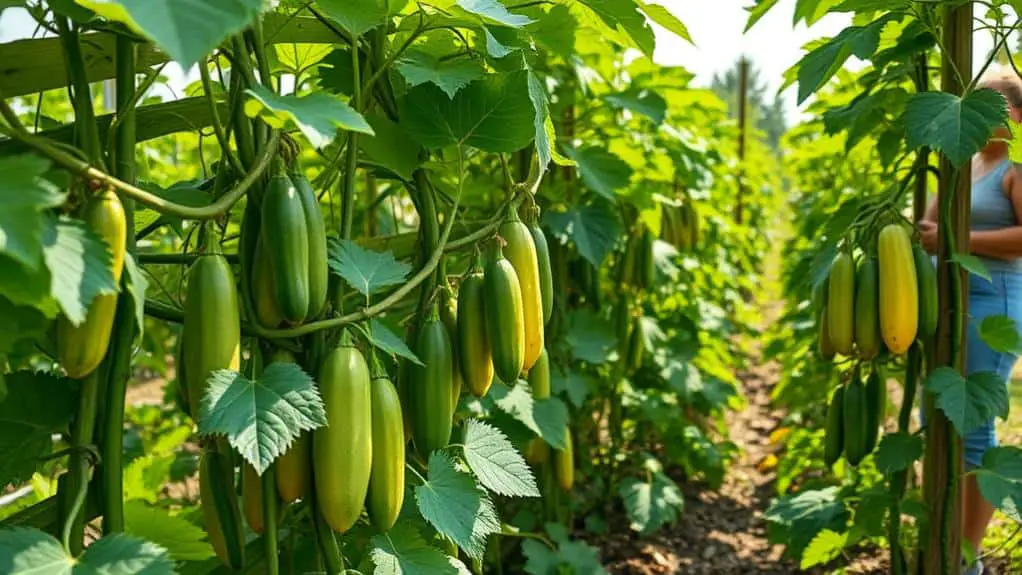
After managing pests effectively, it's time to focus on harvesting cucumbers for the best quality and flavor. Check your plants regularly, as cucumbers should be harvested when they're 6-8 inches long, which generally happens 50-70 days after planting. Regular harvesting keeps the plant productive and prevents over-ripening. Use sharp shears or scissors, twisting gently to avoid damaging the plant. Oversized cucumbers can become bitter, so pick them before they yellow at the blossom end. Here's a quick guide:
| Task | Frequency | Tools Needed |
|---|---|---|
| Check vines | Every 2-3 days | None |
| Harvest cucumbers | When 6-8 inches | Shears/Scissors |
| Avoid over-ripening | Regularly | Observation |
| Prevent bitterness | Harvest promptly | Shears/Scissors |
| Store cucumbers | 7-10 days | Refrigerator |
Storage and Preservation
Making certain cucumbers stay fresh and flavorful after harvest is essential for making the most of your garden's bounty.
After harvesting, store them in the refrigerator for 7-10 days. Wrap each cucumber in a paper towel to absorb excess moisture and prevent spoilage. Remember, don't wash them before storage to avoid mold growth. Harvest cucumbers when they reach 6-8 inches for the best flavor and texture.
- Check vines daily: Pick them before they become overripe.
- Yellowing cucumbers: Remove these to avoid affecting others.
- Pickling: A great preservation method, keeping them for months.
- Cool, dark storage: Essential for pickled cucumbers.
- Follow canning guidelines: Make certain safe, long-term preservation.
These steps will help maintain the quality of your cucumbers.
Frequently Asked Questions
How Close Can You Plant Cucumbers Together?
When planting cucumbers, I space trellised types 12 inches apart for ideal cucumber growth and to manage plant diseases. Proper spacing, companion planting, and variety selection guarantee good soil requirements, watering needs, sunlight exposure, and effective pest control.
What Is the Best Spacing for Cucumbers?
When spacing cucumber varieties, I focus on soil preparation, watering techniques, and trellis options. For sunlight requirements and disease prevention, companion plants help. Proper fertilization methods and pest control guarantee healthy growth, leading to better harvesting tips.
Can You Plant Cucumbers 12 Inches Apart?
You can plant cucumbers 12 inches apart, especially for trellised varieties. This spacing supports ideal growth conditions, sunlight exposure, and pest management. Consider soil requirements, watering frequency, companion planting, and seasonality factors for best results.
Is It Okay to Plant Tomatoes and Cucumbers Together?
I plant tomatoes and cucumbers together as they're great companions. Using trellises for cucumber varieties helps with pest management and disease prevention. Guarantee proper soil requirements, crop rotation, and watering techniques to meet nutrient needs and ideal harvest timing.
Conclusion
So, there you have it! Planting cucumbers with the right spacing is super important for healthy plants and tasty harvests. Whether you're using a trellis or planting directly in the ground, remember to give those cucumbers enough room to breathe and grow. Follow these tips and you'll be munching on fresh, homegrown cucumbers in no time. Happy gardening, and don't forget to enjoy the process—it's all part of the fun!

